Top News
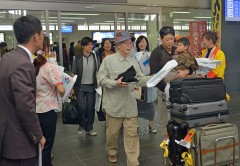
February 9, 2013 Ryukyu Shimpo
On February 8, an Asiana Airlines charter flight carrying 179 tourists arrived from Korea at Miyako Airport in Miyako-jima. This is the first time that Asiana Airlines has offered the flight between Seoul and Miyako-jima. People from the Miyako-jima Tourism Association held a welcome ceremony for the tourists at the airport. The Korean Lotte Tour Development Co. promoted this two-night and three-day tour, which has two options, either playing three rounds of golf at three separate golf courses on the island or sightseeing around Miyako-jima.
At the welcome ceremony, local groups performed eisa and a traditional lion dance, and served the guests mini bottles of locally-produced awamori and mango juice, as well as Orion beer.
Unfortunately, it was a rainy day in Miyako-jima, but the Korean tourists from Seoul, where they have extremely cold midwinter weather with the lowest temperature minus 14 C, were satisfied with the warm temperature. A 57 year-old tourist said, “The sea is beautiful, and I sense the peaceful atmosphere here. I’ve heard that the night sky is beautiful, so I’m looking forward to seeing it.”
(English translation by T&CT, Mark Ealey)
Go to Japanese
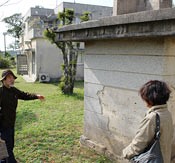
February 6, 2013 Ryukyu Shimpo
On January 25, Masami Shibata of the Osaka-based War Remains Research Association that is engaged in heritage work for war-related sites, researched the Hoan-den in Jahana, in the Motobu district, and then on January 29 visited a location in Tancha that was built to observe enemy aircraft. The association plans to request support from the central and prefectural governments to restore the post to how it was when it was first built.
With regard to the Hoan-den, which enshrined photographs of the Emperor and Empress in a room before and during the war, Shibata said, “It is part of a negative legacy, and few remain in the main islands of Japan. I want to investigate why there are still some in Okinawa.”
The association began to carry out research on the Hoan-den in 2008, and applied to the municipal government to designate it as Important Intangible Cultural Property. Recognizing its historical value, the municipal government did so in October 2010.
Although there are only few in the main islands of Japan, it is reported that there are remains of Hoan-den in Jahana, in Okinawa City and on Ishigaki-jima. Shibata said, “I would like to find out why they remain in Okinawa, which was the scene of one of the most fiercely contested battles in the Pacific War. The central government should designate it as Important Intangible Cultural Property.”
On February 7, the association researched war-related sites in various parts of the prefecture, including the central and southern region of the main island of Okinawa.
(English translation by T&CT, Mark Ealey)
Go to Japanese
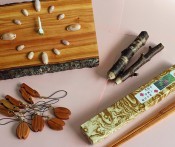
February 2, 2013 Ryukyu Shimpo
In cooperation with the Yuimun Craft Shop, the Motobu Municipal Office has created chopsticks, pens, and straps from the wood from Taiwan cherry trees near Mt. Yaedake that were blown over in last year’s typhoons. They will use of the proceeds to buy and plant new cherry trees. The craft items will be sold at the 35th Motobu Yaedake Cherry Blossom Festival on February 2 and 3, and then at the Motobu Municipal Office after the festival.
In 1963, except for the very summit, Mt. Yaedake was returned to Okinawa from the United States, and since then, the municipal office has planted cherry trees there. The person at the municipal office who is in charge of the project said “We started this from an idea that allowed those trees to be reborn as new products, instead of just disposing of the damaged or fallen trees that we have taken such good care of. We want to use the proceeds to plant new trees and so connect the fallen cherry trees’ life to the next lot of trees.”
Keita Nagamine, who works at the craft shop said, “The wood did not dry so easily so it was difficult to work with, but its aromas and solidness is very good. We want to take good care of the wood from these trees.” They seek to make the best use possible of the wood from the trees by making multi-purpose straps (mostly for attaching to mobile phones) by using the remaining materials from which they made chopsticks. Chopsticks sell for 1000 yen, clocks for 2400 yen, and pens and straps for 500 yen, inclusive of tax.
Please call 0980 (47) 2700, the Motobu Commerce-and-Industry Sightseeing Division for more information.
(English translation by T&CT, Hitomi Shinzato and Mark Ealey)
Go to Japanese
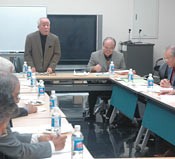
February 8, 2013 Ryukyu Shimpo
On January 29, the Dento Kumi-odori Hozonkai, a voluntary organization to which the professionals of kumi-odori or traditional Okinawan musical belong, was designated as a general incorporated association by the government. Kumi-odori is recognized by the government as an Important Intangible Cultural Property and is also designated as an Intangible Cultural Heritage by UNESCO. Becoming a general incorporated association will allow the Hozonkai to strengthen the organizational structure required to expand the performing arts. They also intend to set up a website and to disseminate information about kumi-odori through photographs, videos and English translations.
On February 6, at the National Theatre Okinawa in Urasoe, a board meeting was held during which there was a report on the incorporation. Through the incorporation, the Hozonkai has become able to receive financial support from the Okinawa Prefectural Culture Promotion Foundation for projects to revitalize, create and promote Okinawan culture. From now on, they will work on promoting development and succession of traditional kumi-odori as part of the project.
Until recently, performers designated as Important Intangible Cultural Property have done their own administrative work. The Hozonkai will hire specialists to manage its systems and make it easier to apply for public support services so as to improve its accounting credibility and the quality of its information dissemination.
During the next fiscal year, they will conduct a promotional project for kumi-odori and consider activities such as performing at schools in order to enhance the studies of script, costume and props, and to provide better financial support and proper training for young performers.
Mitsuharu Shimabukuro, the chairperson of the organization, said, “We hope to hire clerical workers who can manage the Hozonkai. Also we would like to discuss what needs to be done and the creation of a management plan for the future.”
(English translation by T&CT, Lima Tokumori and Mark Ealey)
Go to Japanese
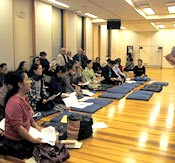
February 4, 2013 Ryukyu Shimpo
By mid-February, the voluntary group the Okinawa Actors’ Association, which is made up of the actors of Uchina shibai or Okinawan plays, will change into a general incorporated association, and start working to reinvigorate Okinawan popular drama. Becoming a general incorporated association will enable the organization to enhance its management and analytical capabilities, which are essential in the context of decreasing audience and actor numbers. The association will carry out training to publicly seek new scripts and to cultivate human resources such as actors and producers. They also intend to perform throughout Okinawa.
On February 3, the proposal to become a general incorporated association was accepted at the general meeting held at the National Theatre Okinawa. On February 4, the association applied to register the change, and this process will be completed by mid-February. The association will start the project called the “Okinawan Theater Renaissance and Popularization Project,” which includes the institutionalization of the Actors’ Association. They will receive support from the Okinawa Prefectural Culture Promotion Foundation. The association will publicly recruit actors in and outside of Okinawa and establish a training system for actors, musicians, producers, and staff for Uchina shibai.
The association was founded in 1947, and since then has worked as a voluntary group aiming to cultivate and improve the standard of actors. By becoming a general incorporated association it aims to enhance its office management in order to make it more effective.
Yoichi Haru, the president of the organization said, “Incorporation means that we need to unite together. We need to create a theater that will attract as many young people as possible.” Morihiro Tsuha, the executive director, said, “We want to find a star among the young actors.”
At 2:00pm, on February 9, to give actors and researchers on opportunity to exchange opinions about future projects at the Urasoe Municipal Gender Equality Promotion Harmony Center, the association will hold a symposium entitled, “Further development of Okinawa Theater.” Admission is free.
For more information, call the association office at 090 (9782) 8568.
(English translation by T&CT, Megumi Chibana and Mark Ealey)
Go to Japanese
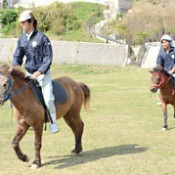
February 4, 2013 Ryukyu Shimpo
The Okinawa Kodomo no Kuni, Zoo & Museum, is working to resurrect Okinawan traditional horse racing called uma-harase, which was lost almost 70 years ago because of the war. Since last October, zookeepers are preparing the unique racing style using the Yonaguni uma horses that are a native breed from Yonaguni Island, and the Jeju horse from Korea. On March 2 and 10, the traditional horse racing will be held at the zoo. Genwa Higa, the chief zookeeper of the Okinawa Kodomo no Kuni said, “Uma-harase highlights an aspect of coexistence between humans and livestock, and is a valuable cultural asset that has its origins in people’s lives. It also has value as a tourist resource.” He is eager to revive and to further establish the event.
It is said that the warrior class began uma-harase during the Ryukyu dynasty, but that it spread to be held among ordinary people such as farmers when the warrior class moved to the rural areas from Shuri after the abolition of feudal domains and the establishment of the prefecture. This event was horseracing involving the small native species of horse. The demand for war-horse type varieties increased, and after World War I it was ordered that existing breeds should be castrated. The breeding of large horses meant that the native species died out and so uma-harase was discontinued.
Uma-harase was held as a part of events such as hama-uri on March 3, in the lunar calendar, an event called abushibare in which people used to repel harmful insects on April 15 and on a full moon night on August 15. At that time, owning a racehorse was a symbol of prosperity and families were proud of winners in uma-harase.
In the uma-harase held in Chibana, Okinawa City, the riders wore festive uniforms made of Chibana hana-ui textiles that are designated as a Japanese traditional craft item. They will appear in clothes made of Chibana hana-ui woven for the one-day event to be held in March.
The most attractive feature of uma-harase is the horses’ unique style of running, in which they compete on the beauty of the performance and pace in running parallel one-to-one, without competing in terms of speed. The race is held with the horse moving its left front and rear legs and right front and rear legs at the same time.
Higa explained that the ambling gait suppressed the shaking of the horse’s back and helped to prevent luggage falling from the horse. He also thinks that this method might have developed in Okinawa to ease the burden on horses walking through the hills and valleys.
(English translation by T&CT, Mark Ealey)
Go to Japanese

Go To Video
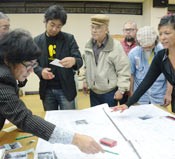
February 7, 2013 Ryukyu Shimpo
Eriko Ikehara, a 49 year-old graduate school student at University of California, Berkeley, has researched the history of the black soldiers’ community that existed from the 1950s until about 1976 in the Teruya district of what was formerly Koza City (currently Okinawa City). Until this January, she based herself in Teruya for about three months in order to gather information from local people who remember those days.
Ikehara has looked into the circumstances in which a black soldiers’ community came to be formed in Okinawa, where locals were also suppressed under U.S. military rule. At the same time, back in the United States the civil rights movement was gaining momentum among the blacks discriminated against by white Americans. She said, “I think that there was something universal in Teruya that should be cherished.” Ikehara refers to herself as an “Uchina-half” – a black woman born between an Uchinanchu mother and a black father. She spent her childhood in the Teruya district, known as the town of black soldiers, so that is where she has her roots.
During her stay, as a project to record the history of the community, she carried out her research with local people at the community center, in pubs and in the Gintengai shopping mall. In a meeting held in the street next to what used to be the black soldiers’ town, she heard about incidents such as robbery and acts of violence towards women by the soldiers. At the same time, she came to understand that there was a feeling of solidarity between the black soldiers and Uchinanchu against the strong grip of the oppressor. For example, she heard that a group of black soldiers carried out a movement with the Zengunro (All-Okinawa Base Workers Union) against the Vietnam War.
Ikehara said, “Koza, is a town that came to life after the Battle of Okinawa. It has an image of rock music, white people’s culture, but it also has another image, that of the soul music belonging to the black people, but this aspect of the city has not been examined in any depth. There is certainly a negative image involving crime, but I think that the black people and Uchinanchu had something in common as people who were discriminated against.”
She said, “Verifying history is the first step toward a better future. I will research the stories of the black soldiers who stayed in Okinawa at that time, and I want to let the Koza Crossroads serve as a junction for friendship between the United States and Okinawa.”
(English translation by T&CT, Mark Ealey)
Go to Japanese
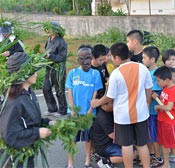
February 5, 2013 Ryukyu Shimpo
On February 4, a traditional ritual known as satiparo was held at Uenonobaru in Miyako-jima. With a child wearing a carved wooden mask and performing as a visiting deity called pantu out in front, 14 women wrapped in vines walked around the community and drove away evil spirits. The satiparo ritual was designated as a significant intangible folk cultural asset in 1993. The event is held annually on the last day of the ox in December of the old calendar. Adult males do not take part, but females and children do.
Women and children gathered at an old well and departed at approximately 6:00pm. Calling out “hoi, hoi,” to the sound of conch shell trumpets and drums, the women wrapped in palm leaves and vines beat bundles of yabunikkei together, and walked through the community with the child performing as the pantu out in front. At intersections, they surrounded children and exorcised evil from them.
Twelve year-old Yota Kudaka, who played the role of the pantu this year as well as last, said, “I am happy to have driven away evil spirits for two years in a row.” Junko Shimajiri, who arranged the ritual as tsukasadum, and so has now completed a full year of service, said, “It was hard to work at my job and to arrange the ritual at the same time. I am relieved that it is over and that it all went well.”
Go to Japanese
February 8, 2013 Ryukyu Shimpo
In his regular press conference held in the afternoon of February 8, Okinawan Governor Hirokazu Nakaima referred to the incident in which a water bottle dropped from an MV-22 Osprey aircraft after it took off from U.S. Marine Corps Futenma Air Station. Nakaima said, “It is absolutely unacceptable that items of cargo fall from aircraft.” He went on to say, “It really is impossible to operate the Osprey from Futenma Air Station when this base is located right in the middle of an urban area. I want the U.S. and Japanese governments to relocate the base outside the prefecture as soon as possible, and to do their utmost to prevent this kind of incident from happening again.” One year has passed since the U.S. and Japanese governments agreed to separate the return of six U.S. military facilities south of Kadena Air Base from the package deal covering the Futenma relocation and the transfer of the Marines outside of Okinawa, but the governments still cannot create an integrated plan to achieve this. Nakaima stated that he will demand that the central government speed up working on the issue, saying, “The previous administration led by the Democratic Party of Japan stated that they would provide us with a specific integration plan at the end of last year. I had expected that the situation would improve despite the administration having changed. I am really disappointed that the central government repeatedly fails to resolve the U.S. base issues in Okinawa despite giving us assertions that it is doing its best.”
With regard to the report that a Chinese naval frigate locked its fire-control radar onto a Japanese ship near the disputed Senkaku Islands in the East China Sea, Nakaima said, “We strongly demand that the Japanese and Chinese governments resolve the dispute through peaceful diplomacy, and that they both do their best to exercise self-control so as not to allow the situation to become explosive.”
Go to Japanese
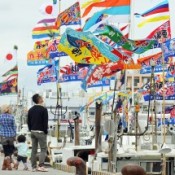
February 11, 2013 Ryukyu Shimpo
In Itoman, many people celebrated on February 10, which is New Year’s Day in the Lunar Calendar. At the fishing port in Itoman, where culture surrounding the lunar calendar still remains, fishermen flew flags and prayed for a big catch. This year, flags from last year’s national convention to promote a bountiful sea were also flown, creating a more colorful and vibrant atmosphere than in normal years. From early morning, many people visited the Hakugindo Shrine, where the gods of the sea are worshipped, and prayed for the safety of their families.
(English translation by T&CT, Mark Ealey)
Go to Japanese

Go To Video
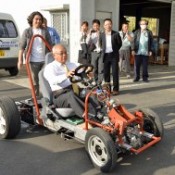
February 2, 2013 Ryukyu Shimpo
On February 1, at the Ecopit garage in Hirara on Miyako-jima, the local municipal office displayed a prototype small electric vehicle (EV) that they have produced in conjunction with local companies. The municipal office is conducting proving trials in order to explore the potential for the production and commercialization small EVs. Many people, including Mayor Toshihiko Shimoji, had a test drive in the car and confirmed it as providing a comfortable ride. The Municipal Small EV Production Association aims to produce an original vehicle in fiscal 2014. This is being carried out as a part of its Smart Energy Island Infrastructure Construction Project, which will run over the three years from fiscal 2012 to 2014.
The prototype is a one-seater vehicle, the frame of which has already been assembled. This small EV was produced by the group, which includes the Okinawa Mold Technology Institute, in Uruma in 2011. The body design of the prototype will be determined at the second meeting of the association for the EV, which will be held in February. Except for the motor and the battery, the prototype is made using materials from the prefecture. Manufacturing Network Okinawa, which has experience in producing EVs, has done most of the assembly work, but in order to build up know-how local automobile maintenance companies will disassemble and re-assembling the prototype car.
Mayor Shimoji said, “We want to push ahead with our dream of making original EVs, and in future selling them within Japan and exporting them to foreign countries.”
(English translation by T&CT, Mark Ealey)
Go to Japanese












 Webcam(Kokusai Street)
Webcam(Kokusai Street)


